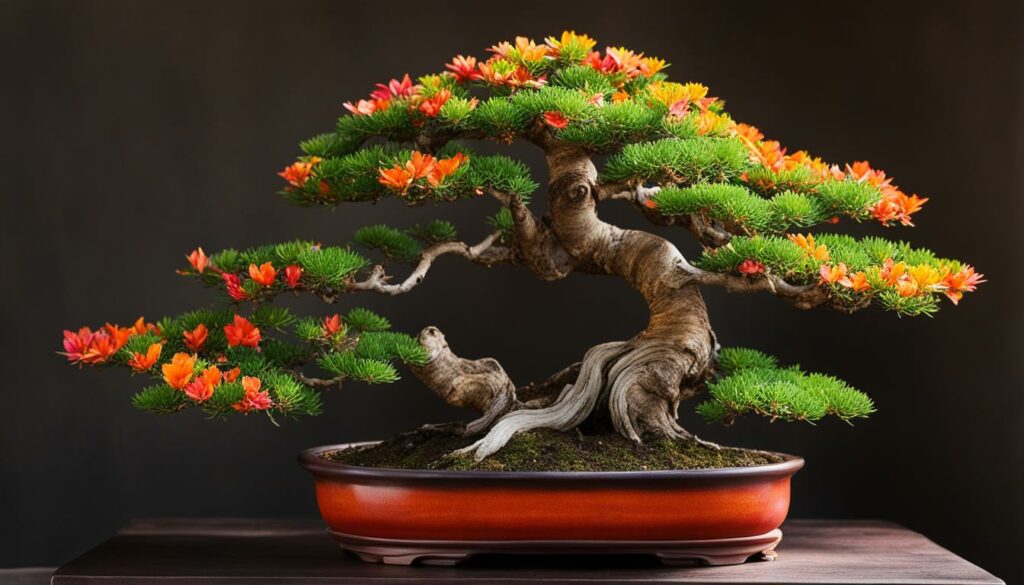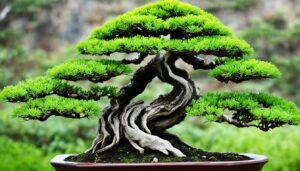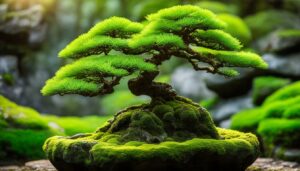Bonsai trees are known for their intricate and visually striking display. Creating aesthetically appealing bonsai compositions is an art that requires a keen eye for detail and skill in styling. Enhancing the colors and foliage of bonsai trees is a crucial aspect of this art, as it creates a visually pleasing composition and highlights the natural beauty of the tree. Vibrant hues and lush textures bring depth to bonsai, making it an attractive decorative piece for your home or garden.
In this article, you will discover how to enhance the colors and foliage of your bonsai trees through pruning, training, and other techniques. You will also learn how to create harmonious color schemes and incorporate native plants and flowers into your bonsai display.
Key Takeaways:
- Enhancing colors and foliage in bonsai styling is vital in creating visually striking compositions.
- Pruning, training, and fertilization techniques can help improve density, color, and health of bonsai trees.
- Native plants and flowers add natural beauty to the bonsai display.
- Seasonal transitions in bonsai tree foliage can be embraced and enhanced.
- Maintaining and displaying colorful bonsai trees require careful care, with specific attention to watering, lighting, and soil requirements.
The Art of Bonsai Styling
Bonsai styling is an art form that requires both technical skill and a deep understanding of aesthetics. To create a visually appealing bonsai tree, you need to consider various factors, including its shape, texture, color, and foliage density.
One of the most important aspects of bonsai styling is achieving an appropriate balance between the tree’s different elements. This involves finding the right proportions for the trunk, branches, and foliage. The right balance creates a harmonious composition that is aesthetically pleasing to the eye.
Another key aspect of bonsai styling is using techniques that enhance the tree’s natural features. This includes pruning and training techniques that encourage healthy growth and improve the tree’s overall shape.
When it comes to color and foliage enhancement, bonsai styling requires a meticulous approach. By choosing the right species of tree and implementing proper care techniques, you can create a bonsai that has vibrant hues and lush textures.
Styles of Bonsai Trees
Bonsai styling is not limited to one particular style. There are various styles to choose from, each with its unique visual appeal.
| Style Name | Description |
|---|---|
| Formal Upright Style | The trunk grows straight up, and the branches are symmetrical and evenly spaced. |
| Informal Upright Style | The trunk has a slight curve, and the branches are not evenly spaced or symmetrical. |
| Cascade Style | The trunk grows out of the pot and then cascades downward, creating a waterfall-like effect. |
| Semi-Cascade Style | The trunk grows out of the pot at an angle and then cascades downward. |
| Broom Style | The trunk grows straight up, and the branches are horizontal and evenly spaced, giving it the appearance of a broom. |
Each style of bonsai has its unique requirements when it comes to styling and care. Becoming familiar with the different styles and their characteristics is essential to creating a visually appealing bonsai collection.
Overall, bonsai styling is an art form that requires attention to detail and a deep appreciation for the natural beauty of trees. By taking a thoughtful and meticulous approach to styling and care, you can create a collection of stunning bonsai trees that will enrich your living space.
Understanding Leaf Coloration in Bonsai
Color is an essential element to consider when enhancing the aesthetic appeal of your bonsai trees. Apart from foliage density and shape, the color of the leaves also plays a crucial role in creating stunning bonsai compositions. This section will take you through the science of leaf coloration and show you how to incorporate this element to create vibrant bonsai arrangements.
Leaf coloration is a result of plant pigments varying among species, with the most common pigments being chlorophyll, anthocyanins, and carotenoids. Chlorophyll, the most prevalent pigment, gives leaves their green color as it is essential for photosynthesis. Anthocyanins, on the other hand, create reddish, yellow and purple hues, while carotenoids are responsible for orange and yellow hues.
Some bonsai species have naturally colorful leaves, while others may require additional care and techniques to enhance their hue. The color of the leaves can also be affected by factors such as light exposure, soil nutrients, and temperature changes, which can result in different shades of the same color.
When selecting bonsai trees, look for species with naturally colorful foliage such as Acer palmatum (Japanese Maple) or Ficus microcarpa (Chinese Banyan) to ensure an eye-catching display. You can also enhance the color of your bonsai through techniques such as pruning and fertilization.
Types of Leaf Coloration
| Color | Pigment | Species Example |
|---|---|---|
| Green | Chlorophyll | Boxwood, Juniper, Pine |
| Red, Yellow, Purple | Anthocyanins | Japanese Maple, Dogwood, Azalea |
| Orange, Yellow | Carotenoids | Japanese Zelkova, Ginkgo, Honeylocust |
Anthocyanins create the red, yellow and purple hues seen on many bonsai trees. This pigment is affected by environmental factors such as temperature changes, sunlight intensity, and soil acidity. During autumn, anthocyanin levels rise, and the leaves change color, creating a stunning visual display.
Carotenoids create orange and yellow colors and are found in fruits and some vegetables, as well as in leaves. These pigments are more prevalent during autumn as they mask the chlorophyll green, creating the golden hues we see around us.
Each species has its unique leaf coloration, which adds to the diversity and versatility of bonsai styling. Understanding leaf coloration and how to enhance it is fundamental to achieving vibrant hues in your collection.
Enhancing Foliage through Pruning and Training
In bonsai styling, foliage enhancement is a crucial aspect of creating a visually appealing display. Pruning and training techniques are essential for improving the density and overall health of bonsai tree foliage, resulting in enhanced visual appeal. Pruning allows for targeted removal of branches and leaves to shape and direct the growth of the tree.
Training techniques such as wiring, wrapping, and bending are used to manipulate the growth of the tree into the desired shape and form. A well-trained bonsai tree with healthy foliage creates an impression of harmony and balance.
By carefully pruning and training your bonsai tree, you can create stunning foliage arrangements that capture the essence of natural growth patterns. A healthy bonsai tree with dense, lush foliage and vibrant colors is a true masterpiece of bonsai styling.
Remember to handle pruning and training with care, as improper techniques can cause damage to the tree. Always consult with a trusted bonsai professional for guidance and advice.
Pruning Techniques
| Technique | Benefit |
|---|---|
| Pinching | Encourages branching and fuller foliage growth |
| Thinning | Removes excess foliage to improve air circulation and nutrient flow to the remaining leaves |
| Leaf pruning | Removal of leaves to encourage new growth and direct the growth of the tree |
Training Techniques
| Technique | Benefit |
|---|---|
| Wiring | Allows for precise control of the direction and shape of branches |
| Wrapping | Restricts the growth of specific branches to encourage new growth in other areas |
| Bending | Allows for the shaping and directing of the overall form and structure of the bonsai tree |
Remember, over-pruning and over-training your bonsai tree can lead to damage or even death. Always be patient and follow proper techniques for the health of your tree.
Bonsai Flowering Varieties
If you want to add a pop of color to your bonsai display, consider incorporating flowering varieties into your collection. Bonsai trees can feature blooms in a wide range of colors, including pink, white, red, and yellow, which can enhance the visual appeal of your composition. Flowering bonsai trees can also add a touch of elegance and beauty to your indoor or outdoor space.
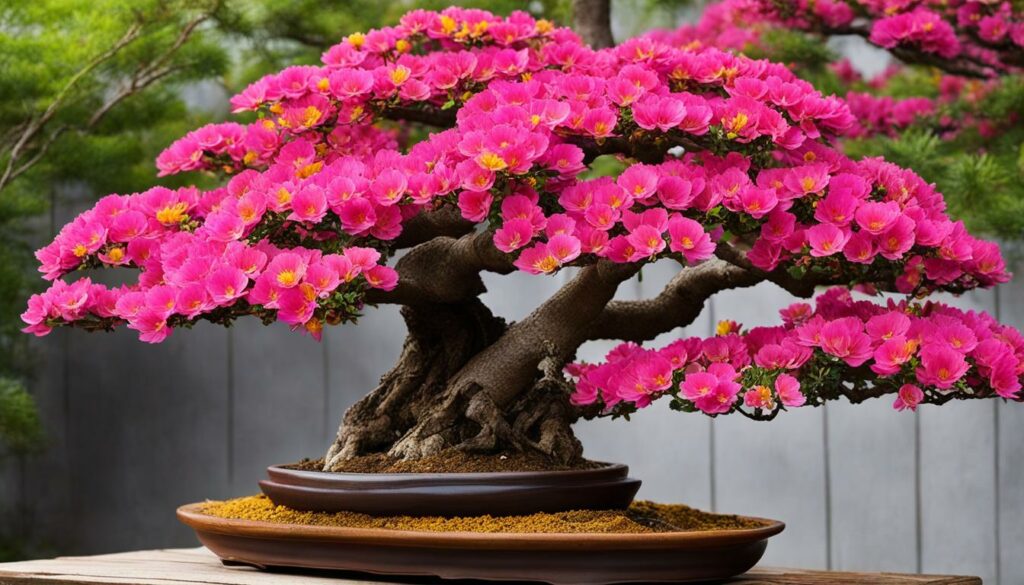
| Bonsai Tree | Flower Color |
|---|---|
| Japanese Cherry | Pink or white |
| Camellia | Pink, white, or red |
| Wisteria | Purple or white |
| Azalea | Pink, red, or white |
When choosing a bonsai tree with blooms, be sure to consider the overall aesthetics of your composition and select colors that complement the foliage and other elements of your display. Remember, the goal is to create a harmonious and visually appealing composition of color and texture.
Selecting Bonsai with Colorful Foliage
Choosing the right bonsai tree is crucial if you want to add color and vibrancy to your collection. Look out for natural leaf colors that are bright, rich, and distinct, such as fiery reds, bright pinks, and deep greens. Some of the most popular bonsai trees with colorful foliage include:
| Bonsai Tree | Color |
|---|---|
| Japanese Maple | Red, purple, green |
| Twisted Olive | Green, silver, yellow |
| Ficus | Green, yellow, variegated |
| Juniper | Green, blue, gray |
| Smoke Tree | Green, purple, pink |
Aside from the foliage color, inspect the overall health and appearance of the tree, making sure it has a strong, thick trunk, and well-developed branches.
Expert Tip:
When selecting a bonsai tree, consider the color of its blooms as well. Certain species, such as the Japanese Cherry Blossom and the Azalea, produce stunning flowers that can complement the colorful foliage of other trees in your collection.
With a careful eye and a bit of research, selecting bonsai trees with colorful foliage can be a rewarding and fascinating experience!
Applying Techniques for Foliage Enhancement
To achieve the most visually appealing bonsai compositions, it’s essential to enhance the foliage of your trees. Here are specific techniques and practices you can use to achieve foliage enhancement for your bonsai:
Pinching
Pinching is a technique used to encourage branching and create denser foliage. Use your fingers or pruning shears to pinch off the tips of new growth, which will force the tree to grow more compactly and develop new shoots. This technique should be done during the growing season, and you should avoid pinching a single branch too often.
Defoliation
Defoliation is the removal of all or most of a tree’s leaves. This technique encourages new growth and reduces leaf size. It should be done when the tree is the most vigorous and healthy, usually in the height of the growing season. However, it’s vital to avoid defoliating the same tree too often, as this can weaken the tree and stunt its growth.
Fertilization
The proper fertilization of your bonsai tree can result in better foliage production, especially if it lacks nutrients. Nitrogen-rich fertilizers are best for promoting healthy foliage growth. It’s essential to fertilize your tree during the growing season to ensure it gets the necessary nutrients to thrive. However, using too much fertilizer can harm the tree, so make sure you stick to the recommended amount.
Foliage Enhancement Techniques
| Technique | Description |
|---|---|
| Pinching | Removing the tips of new growth to encourage branching and denser foliage. |
| Defoliation | Removing all or most of a tree’s leaves to encourage new growth and reduce leaf size. |
| Fertilization | Providing your tree with the necessary nutrients to promote healthy foliage growth during the growing season. |
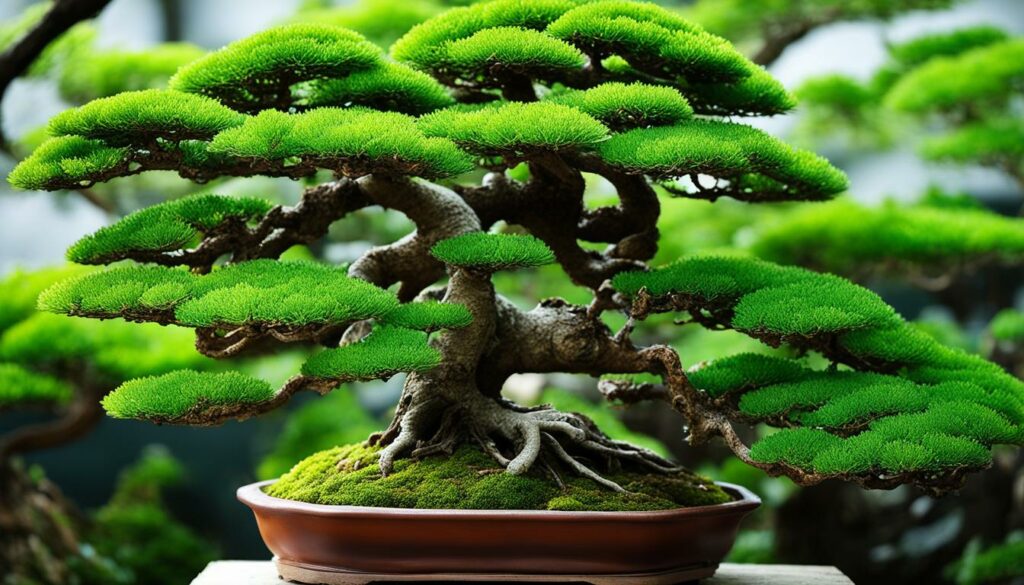
Incorporating Native Plants and Flowers
One way to enhance the natural beauty and colors of your bonsai trees is by incorporating native plants and flowers into your compositions. By selecting plants and flowers that are indigenous to your area, you can create a display that celebrates the unique flora of your region.
Bonsai flowering varieties such as Azaleas, Cherry Blossoms, and Dogwood are popular choices for adding pops of color to your collection, and their blooms can be timed to coincide with seasonal changes for a dynamic display.
When selecting native plants for your bonsai compositions, consider foliage color and texture as well. Pay attention to the hues and shapes of leaves, as well as the overall structure of the plant. A well-chosen companion plant can complement your bonsai tree’s colors and bring added interest to the overall display.
For example, consider the subtle variations in color and texture between pine needles and oak leaves, as shown in the table below:
| Tree | Leaf Color | Leaf Texture |
|---|---|---|
| Pine | Green/Yellow | Needle-like |
| Oak | Green/Red | Lobed |
By thoughtfully selecting complementary colors and textures, you can create a harmonious display that accentuates the natural beauty of your bonsai trees and the local environment.
Color Schemes and Combinations in Bonsai
To create a visually appealing bonsai composition, it’s important to consider the color scheme and combinations. This involves selecting trees with complementary colors and arranging them in a harmonious way.
The most common color scheme used in bonsai styling is the complementary scheme, which involves pairing colors that are opposite each other on the color wheel. For example, green leaves paired with red or purple flowers. This creates a striking contrast that draws the eye and creates visual interest.
Analogous color schemes, which involve pairing colors that are adjacent to each other on the color wheel, can also work well in bonsai styling. This creates a more subtle and harmonious effect. For example, pairing green with yellow or orange creates a warm and inviting composition.
Another popular approach is to create a monochromatic color scheme, where different shades and tints of the same color are used. This can create a calming and cohesive effect. For example, using different shades of green in a bonsai composition can create a sense of tranquility and balance.
When selecting trees for a bonsai composition, it’s important to consider the color of the foliage, flowers, and bark. You can also use accent plants and rocks to add depth and texture to the composition.
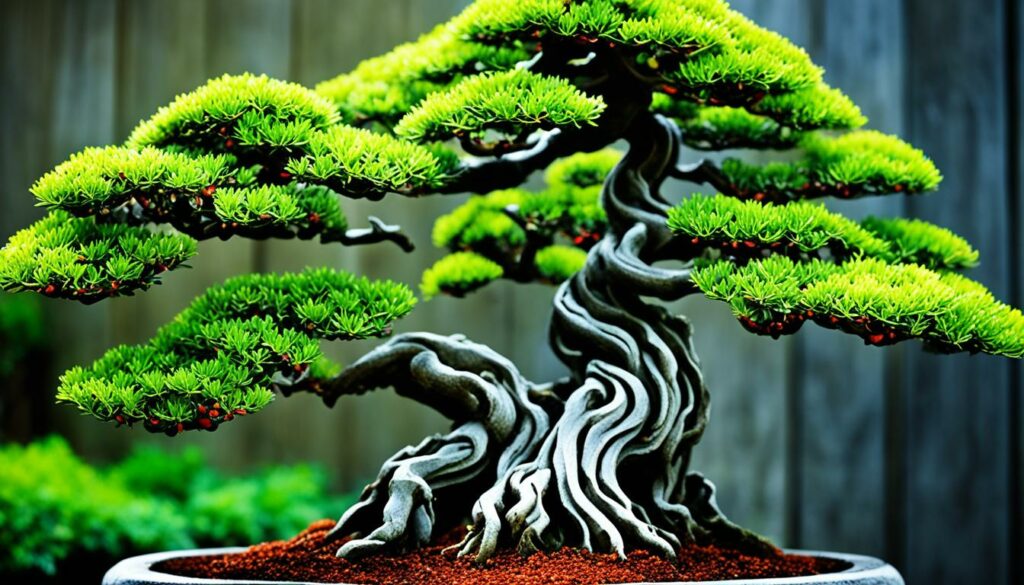
Experimenting with different color schemes and combinations is part of the fun of bonsai styling. Whether you prefer bold and contrasting compositions or subtle and harmonious ones, enhancing the colors and foliage of your bonsai trees will create a stunning and eye-catching display.
Seasonal Foliage Changes in Bonsai
As the seasons change, the foliage of bonsai trees undergoes a natural transformation. Understanding how to embrace and enhance these changes is crucial for maintaining the beauty of your bonsai collection.
During the autumn months, the leaves of deciduous bonsai trees begin to change color, creating a stunning display of reds, oranges, and yellows. This natural phenomenon, known as leaf coloration, is caused by a reduction in chlorophyll production and the presence of pigments such as carotenes and anthocyanins. By embracing this change, you can enhance the visual impact of your collection.
One way to enhance the seasonal foliage changes in bonsai trees is to choose varieties with naturally vibrant fall colors, such as Japanese maple or ginkgo. Additionally, proper care during this season is crucial, including providing adequate water and ensuring the appropriate amount of sunlight exposure.
During the winter months, evergreen bonsai trees may experience a browning or yellowing of their foliage due to fluctuations in temperature and sunlight exposure. While this can be concerning, it is important to remember that it is a natural response to the changing environment. By providing proper care and ensuring the tree is not exposed to extreme conditions, you can promote healthy growth and prepare for the next season.
As the seasons change and the foliage of bonsai trees evolves, it is essential to embrace and enhance these natural transitions. Incorporating seasonal changes into your bonsai styling can add depth and interest to your collection while promoting the health and longevity of your trees.
Caring for Colorful Bonsai Trees
After going through the effort of enhancing the colors and foliage of your bonsai trees, it’s important to keep them healthy and vibrant. Here are some practical tips for maintaining your colorful bonsai collection:
Watering
One of the most important things you can do for your bonsai trees is to ensure they are properly watered. Water your trees regularly, checking the soil moisture level frequently. Avoid overwatering or underwatering your trees, as this can lead to root rot or dehydration. Use a watering can or hose with a diffuser nozzle to gently water your bonsai and ensure even distribution.
Light Exposure
Bonsai trees thrive in bright, indirect sunlight. Place your trees near a south-facing window or outside in a spot with filtered light. Monitor the amount of light your trees receive, as too much direct sunlight can scorch the leaves and hinder growth. Consider using a grow light if natural light is insufficient or unavailable.
Soil Care
The quality of the soil is crucial to the health of your bonsai trees. Use well-draining soil designed specifically for bonsai, and avoid heavy, compacted soils that can suffocate the roots. Check the pH level of your soil and adjust as necessary. Fertilize your trees regularly, using a balanced liquid fertilizer to promote healthy growth and vibrant colors.
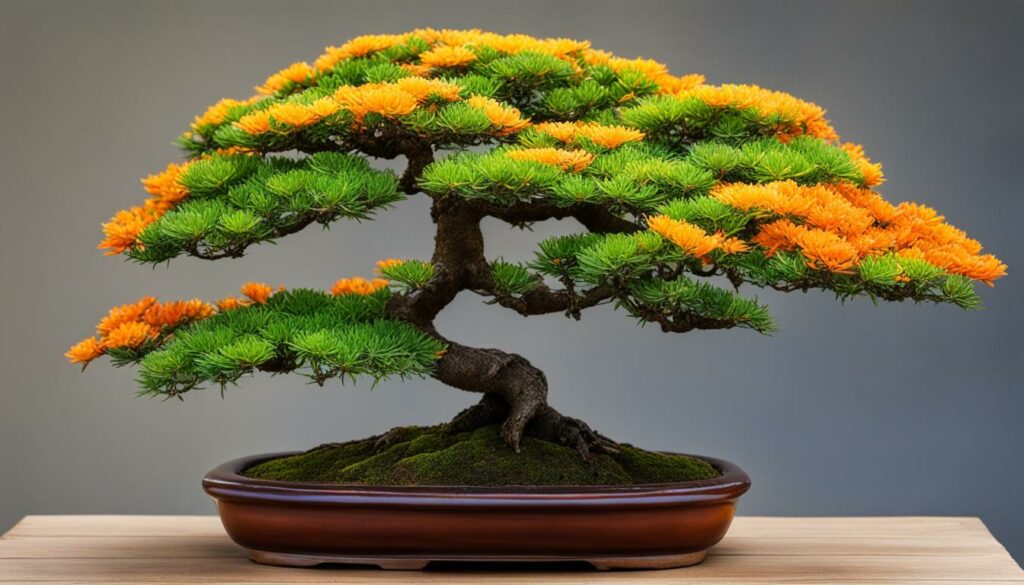
Pruning and Maintenance
Regular pruning and shaping is essential for the health and visual appeal of your bonsai trees. Use sharp, clean pruning tools and trim branches and leaves as needed to maintain the desired shape and density. Remove any dead or damaged branches to prevent disease and promote new growth. Conduct maintenance checks regularly to nip any problems in the bud.
Displaying Colorful Bonsai Trees
Once you’ve put in the effort to enhance the color and foliage of your bonsai trees, it’s time to display them in a way that will truly showcase their beauty. Here are some techniques for displaying your colorful bonsai trees:
Accent Plants
Pairing your bonsai tree with accent plants can bring out its colors and foliage. Consider complementary plants that will enhance the overall composition. For example, pair a red-leafed tree with a green-leafed accent plant to create a striking color contrast.
Display Stands
Using a display stand can elevate your bonsai tree and create a focal point in your space. Choose a stand that complements the colors and style of your tree and place it in a well-lit area to enhance its vibrancy.
Seasonal Displays
Adjust the display of your bonsai tree to reflect the changing seasons. For example, in the fall, display your tree with colorful fall foliage and autumn-themed accessories. In the winter, decorate the area with twinkling lights and festive ornaments. This will add interest and variety to the display throughout the year.
“Proper display ensures that your bonsai tree is seen in its best light, highlighting the beauty and personality of the tree.”
By incorporating these techniques, you can showcase the beauty of your colorful bonsai trees and create a stunning focal point in your space. Bonsai Styling Color and Foliage Enhancement techniques take patience and technique, and gaining the most benefit from the completed work involves a proper display. Get started today and experiment with different combinations until you find the perfect display for your unique bonsai tree collection.
Exploring Bonsai Styling Trends
As bonsai styling continues to grow in popularity, new color and foliage enhancement techniques are emerging within the community. Bonsai enthusiasts are experimenting with various methods to create unique, visually stunning compositions that reflect their personal styles.
One trend that has gained traction in recent years is the use of organic materials to enhance bonsai trees’ natural beauty. For instance, incorporating natural rocks, moss, and driftwood can create a more authentic look that complements the bonsai tree’s style. Moreover, using organic materials to complement a bonsai’s foliage can also add depth and dimension to the composition.
In addition, bonsai styling techniques are evolving to embrace a more naturalistic approach to design. For example, the use of asymmetrical styles and negative space is becoming increasingly popular, as it creates a more natural-looking composition. Moreover, the use of foliage enhancement techniques such as pinching, defoliation, and pruning is gaining popularity, as bonsai enthusiasts look to create visually appealing, healthy trees.
As the art of bonsai styling continues to evolve, it is essential to stay up-to-date with the latest trends and techniques. By embracing the latest trends, bonsai enthusiasts can create captivating, stylish compositions that showcase their unique talents and style.
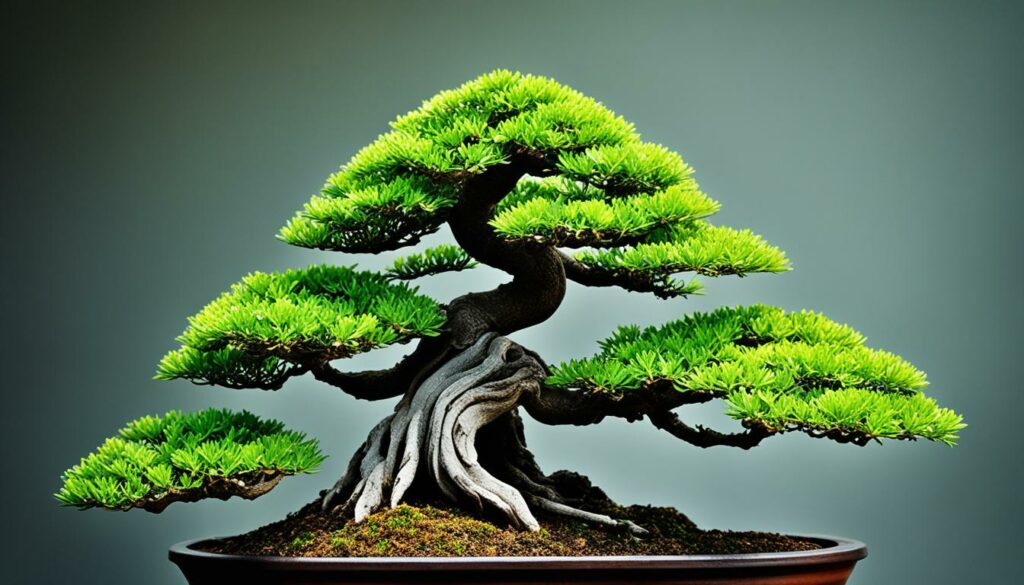
Bonsai Styling Trends Table
| Trend | Description |
|---|---|
| Organic Materials | Incorporating natural rocks, moss, and driftwood to enhance the bonsai’s natural beauty. |
| Naturalistic Design | Embracing asymmetrical styles, negative space, and natural-looking compositions. |
| Foliage Enhancement | Using techniques such as pinching, defoliation, and pruning to create visually appealing, healthy trees. |
Conclusion
Enhancing the colors and foliage in bonsai styling adds a unique element of beauty to your collection. With techniques such as pruning and training, foliage enhancement, and selecting colorful varieties, you can create visually appealing compositions that showcase the natural beauty of your bonsai trees. Careful attention to color schemes and seasonal changes further enhance the artistry of your display. By incorporating these practices into your bonsai care routine, you can enjoy the vibrant blooms and lush foliage of your bonsai collection year-round.
FAQ
How can I enhance the colors and foliage in my bonsai styling?
There are several techniques you can use to enhance the colors and foliage of your bonsai trees. These include selecting bonsai with naturally colorful foliage, practicing pruning and training techniques, and incorporating native plants and flowers for added visual interest.
Why is leaf coloration important in bonsai?
Leaf coloration plays a crucial role in the overall appearance of bonsai trees. Different leaf colors can add depth and variety to your composition, creating a more visually appealing and dynamic display.
How can I enhance the foliage density of my bonsai trees?
Pruning and training are two effective techniques for enhancing the foliage density of your bonsai trees. By strategically removing unwanted branches and encouraging new growth, you can achieve a fuller and healthier foliage appearance.
Are there bonsai trees that flower?
Yes, there are many bonsai trees that have flowering varieties. These blooming trees can add vibrant colors to your bonsai collection, creating a visually stunning display.
How do I select bonsai trees with colorful foliage?
When selecting bonsai trees, look for species that naturally have colorful foliage. Some examples include the Japanese maple with its stunning red leaves or the Chinese elm with its beautiful yellow autumn foliage.
What techniques can I use to enhance the foliage of my bonsai trees?
There are several techniques you can employ to enhance the foliage of your bonsai trees. These include pinching, defoliation, and proper fertilization to encourage healthier and more vibrant leaves.
Can I incorporate native plants and flowers in my bonsai styling?
Yes, incorporating native plants and flowers in your bonsai styling can create a more natural and authentic display. It allows you to showcase the beauty and colors of the local environment.
How can I create harmonious color schemes in my bonsai compositions?
To create harmonious color schemes in your bonsai compositions, consider the color wheel and the relationships between complementary and analogous colors. This will help you create visually pleasing combinations that enhance the overall appeal of your bonsai display.
How do seasonal changes affect the foliage colors of bonsai trees?
Seasonal changes have a significant impact on the foliage colors of bonsai trees. For example, many deciduous trees display vibrant autumn colors before shedding their leaves. Embracing these seasonal changes and enhancing them through proper care and pruning can create stunning displays throughout the year.
How can I care for my colorful bonsai trees?
Caring for colorful bonsai trees involves providing them with proper watering, light exposure, and soil care. It is crucial to maintain a balanced environment that supports the health and vibrant colors of your bonsai trees.
What are some techniques for displaying colorful bonsai trees?
When displaying colorful bonsai trees, consider using accent plants, display stands, and seasonal displays to enhance their beauty. These techniques can help you create visually appealing compositions that showcase the vibrant colors and lush foliage of your bonsai trees.
What are the current trends in bonsai styling?
Currently, there is a growing trend in bonsai styling that focuses on enhancing colors and foliage. Bonsai artists are experimenting with new techniques and innovations to create visually stunning compositions that push the boundaries of traditional bonsai aesthetics.
